The ASRock AB350 Gaming K4 Motherboard Review: Dual M.2 at $90
by Gavin Bonshor on April 9, 2018 9:00 AM ESTSystem Performance
Not all motherboards are created equal. On the face of it, they should all perform the same and differ only in the functionality they provide - however, this is not the case. The obvious pointers are power consumption, but also the ability for the manufacturer to optimize USB speed, audio quality (based on audio codec), POST time and latency. This can come down to manufacturing process and prowess, so these are tested.
Power Consumption
Power consumption was tested on the system while in a single ASUS GTX 980 GPU configuration with a wall meter connected to the Thermaltake 1200W power supply. This power supply has ~75% efficiency > 50W, and 90%+ efficiency at 250W, suitable for both idle and multi-GPU loading. This method of power reading allows us to compare the power management of the UEFI and the board to supply components with power under load, and includes typical PSU losses due to efficiency. These are the real world values that consumers may expect from a typical system (minus the monitor) using this motherboard.
While this method for power measurement may not be ideal, and you feel these numbers are not representative due to the high wattage power supply being used (we use the same PSU to remain consistent over a series of reviews, and the fact that some boards on our test bed get tested with three or four high powered GPUs), the important point to take away is the relationship between the numbers. These boards are all under the same conditions, and thus the differences between them should be easy to spot.
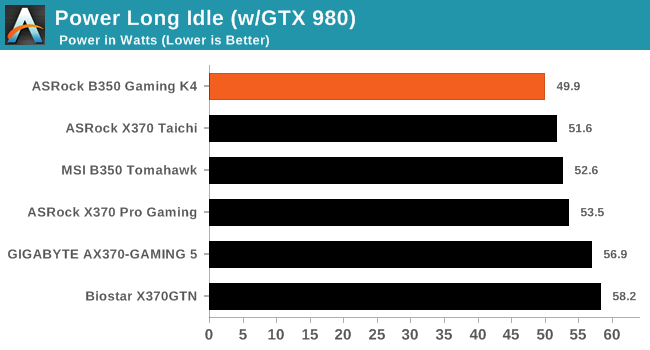
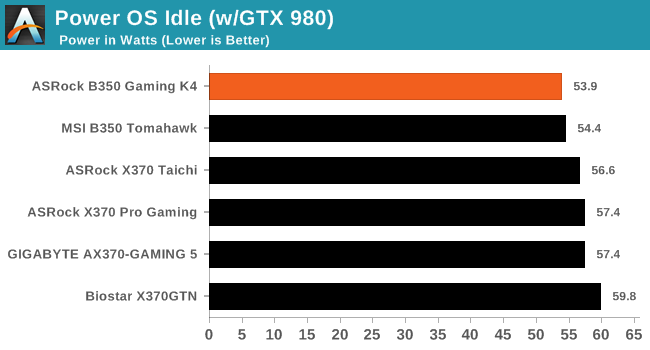
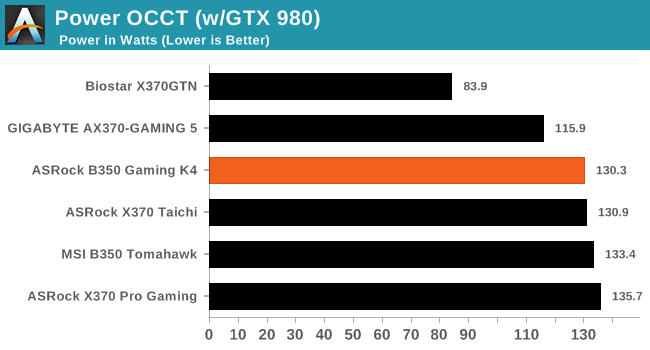
In idle and long idle power states, the AB350 Gaming K4 sits with the lowest numbers out of the AM4 boards tested thus far, but this is most likely due to how sparse the PCB which is attested to how basic a model this board actually is in comparison to some in the graphs. At load, we get results similar to other ATX motherboards in this space.
Non-UEFI POST Time
Different motherboards have different POST sequences before an operating system is initialized. A lot of this is dependent on the board itself, and POST boot time is determined by the controllers on board (and the sequence of how those extras are organized). As part of our testing, we look at the POST Boot Time using a stopwatch. This is the time from pressing the ON button on the computer to when Windows starts loading. (We discount Windows loading as it is highly variable given Windows specific features.)
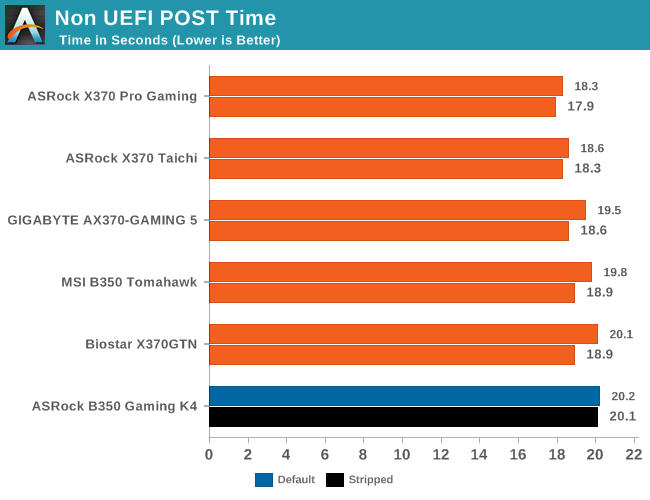
The majority of the POST times seem to align with each other within a second or two, although turning the controllers off didn't make any difference.
Rightmark Audio Analyzer 6.2.5
Rightmark:AA indicates how well the sound system is built and isolated from electrical interference (either internally or externally). For this test we connect the Line Out to the Line In using a short six inch 3.5mm to 3.5mm high-quality jack, turn the OS speaker volume to 100%, and run the Rightmark default test suite at 192 kHz, 24-bit. The OS is tuned to 192 kHz/24-bit input and output, and the Line-In volume is adjusted until we have the best RMAA value in the mini-pretest. We look specifically at the Dynamic Range of the audio codec used on the rear panel of the board.
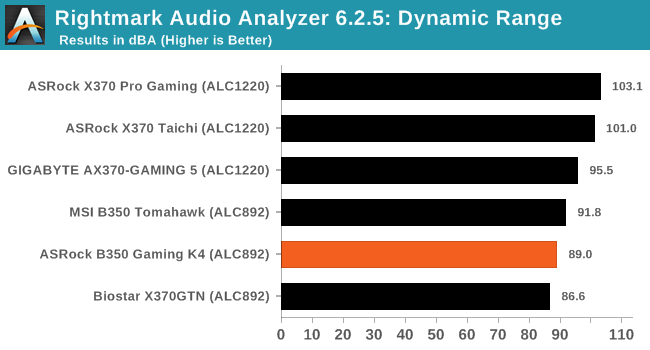
The trend of performance is clear in the above graph, especially when the ALC1220 laden boards sit consistently higher in dynamic range than the more cost effective ALC892 codecs.
DPC Latency
Deferred Procedure Call latency is a way in which Windows handles interrupt servicing. In order to wait for a processor to acknowledge the request, the system will queue all interrupt requests by priority. Critical interrupts will be handled as soon as possible, whereas lesser priority requests such as audio will be further down the line. If the audio device requires data, it will have to wait until the request is processed before the buffer is filled.
If the device drivers of higher priority components in a system are poorly implemented, this can cause delays in request scheduling and process time. This can lead to an empty audio buffer and characteristic audible pauses, pops and clicks. The DPC latency checker measures how much time is taken processing DPCs from driver invocation. The lower the value will result in better audio transfer at smaller buffer sizes. Results are measured in microseconds.
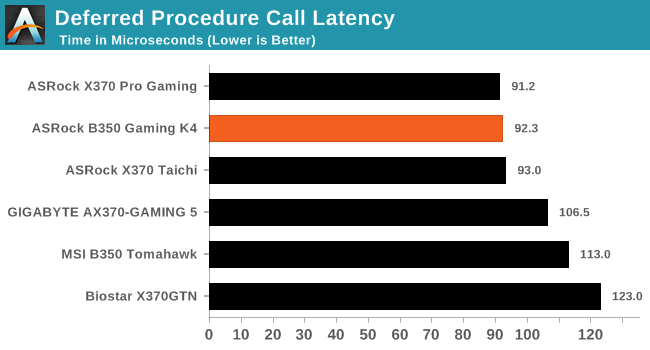
None of the manufacturers we have seen so far on B350/X370 have optimized their boards for DPC latency, but each board consistently remained below 150 microseconds. All three of the ASRock options tested perform well, even the low cost AB350 Gaming K4 on review today.










43 Comments
View All Comments
jhensjh - Tuesday, April 10, 2018 - link
Here's a couple typos for a start: "it compounts the issue.", "controllers, which which is to be expected". This article ranges from rambling sentences with excessive comma splices to bordering on nonsensical. An example of the former:"For manual overclocks, based on the information gathered from previous testing, starts off at a nominal voltage and CPU multiplier, and the multiplier is increased until the stability tests are failed."
And the latter:
"This would empty more thermal energy into the heatsinks"
vkristof - Tuesday, April 10, 2018 - link
I want to thank the author for starting to address WHY socket AM4 motherboard manufacturers do not promote/use/whatever the USB 3.1 Gen 2 ports that the AMD chipset supports.However, I assume there's at least one typo in his statement "Despite the chipset supporting USB 3.1 (10 Gbps), ASRock saves some effort in the mode complicated traces by relying on USB 3.0 instead". I assume "mode complicated" should be "MORE complicated" traces. Or?
In addition, why do they plop Asmedia USB 3.1 Gen2 controllers on some of these motherboards to provide gen 2 speeds?
I assume the Asmedia controllers require the same 10+ Gbps differential pair trace routing rules that the B350 chip does. Unless the B350 serdei are less forgiving? Or routing the 10+ Gbps pairs to the high ball count B350 requires more PCB layers?
Anyway, thanks.
Round - Tuesday, April 10, 2018 - link
"If you see any errors or typos, please by all means let us know."LOL. I appreciate the articles, but you've got to be joking, right? You don't see them? They're legion. Besides those already pointed out, take a gander at this gem...
"In regards to the performance, there wasn’t any problems or..."
I'm surprised (and sadly appalled) that it has to be pointed out, but your statement
"Time is fleeting and Google cares more about who's first than who's best..."
is a weak excuse, and nothing more. Anyone can spend 5-10 minutes before publishing. What passes for writing today has me convinced we're ready to collapse into the second coming of the dark ages, where people can't form structured sentences, don't understand tenses, plurals and possessives, or the use of adjectives and adverbs.
Glock24 - Tuesday, April 10, 2018 - link
If this was an article published on the day the media embargo expires for a new product launch I would understand the hurry to publish and lack of proper editing, but this board was launched to the market like a year ago. So why the hurry?Aspernari - Tuesday, May 8, 2018 - link
So a month later, and the editing staff and users haven't managed to catch this:"but this means the onboard audio usese the Realtek RTL8111 networking chip and the Realtek ALC892 audio codec"
A) No, it means the onboard audio is the Realtek ALC892 chipset, and the networking chip is the Realtek RTL8111. We're in deep trouble if the onboard audio is using the RTL8111.
B) It doesn't usese anything. How did that pass basic spellcheck?
PeachNCream - Tuesday, April 10, 2018 - link
Purch generates income from catching and keeping an audience that regularly visits the sites it publishes. It's against the financial interests of the company to drain AnandTech and sell it off when it dies and it's silly to imply that's happening now.In the case of this review, I'm glad to see there are mid-priced motherboards getting a little attention and it's really nice to see something other than a MSI x299 board for once since there's been quite a few of them rolling through of late.
Tewt - Tuesday, April 10, 2018 - link
I thought that must of been a mistake as well. The time for a consumer to research these motherboards that haven't been reviewed yet is nearly over so what is even the point? I had just assumed Anandtech has had a review of the ASRock X370 Taichi board for some time. I will be researching AMD 2000 cpus and 400 series boards in the next few months not older 300 series. /scratches head at Anandtech timelineRyan Smith - Tuesday, April 10, 2018 - link
Let me put things this way: we wouldn't have taken the time to review this board if we didn't think it would be relevant in the future...neogodless - Tuesday, April 10, 2018 - link
That's brilliant! (I've been strongly considering this board and a Ryzen 1700, but I've put it off long enough to wait and see what Ryzen 2xxx brings to the table (and for RAM to, like, not even bankrupt me.) Also I live near Microcenter where this board is just $50 w/ a Ryzen...Ratman6161 - Wednesday, April 11, 2018 - link
Except...one critical thing is missing in the article in the discussion of the 2200g or 2400G. That is that if you buy this motherboard, or any other existing motherboard you are taking a crap shoot on weather you will get a board that has a bios that will support the newer processor. I was considering a 2200g build for my wife until I realized that to make it work, I'd probably have to pull the R51600 out of my system and put it in the new board just so I could update the bios...or give her the motherboard from my system since that's already updated. I decided it would be easier for me to just wait a bit for the newer motherboards to come out.I too live near a Microcenter...gotta love it!